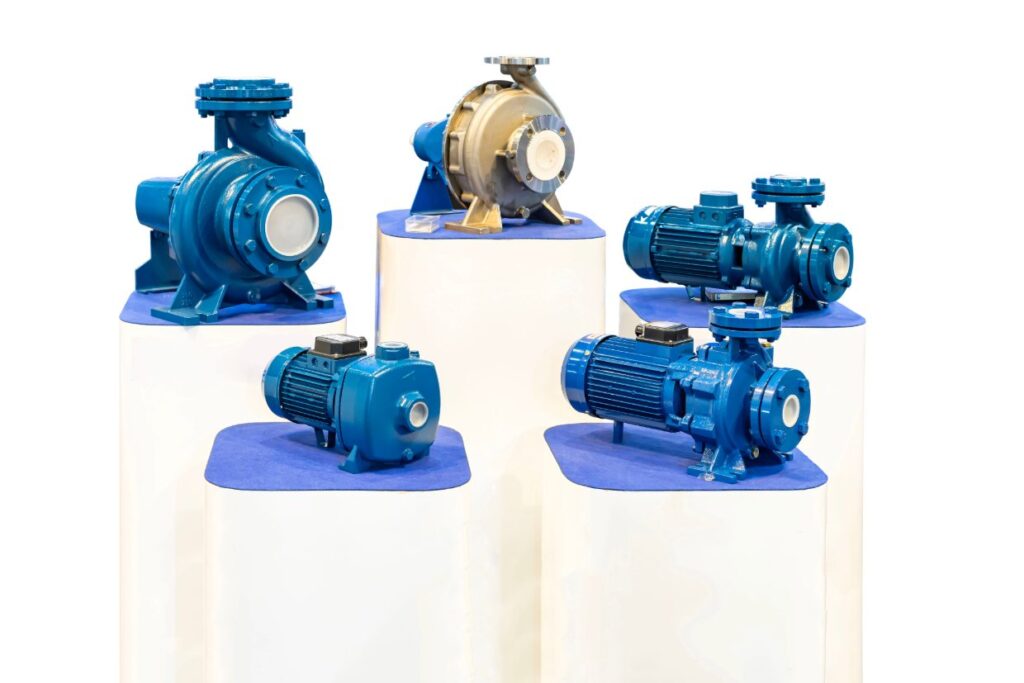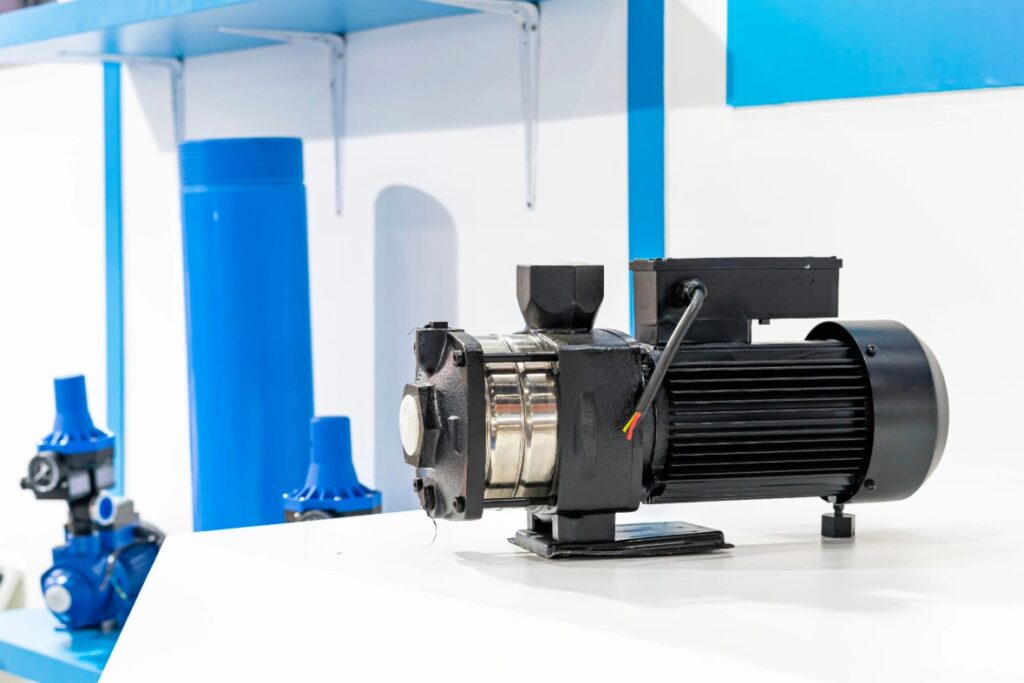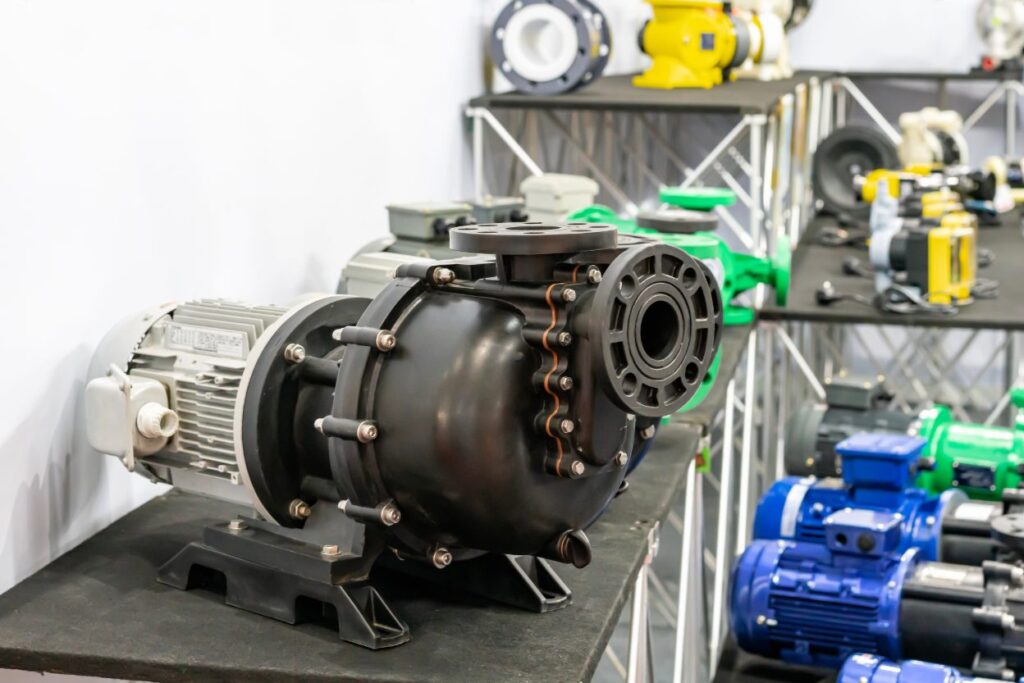A high head pump, a pinnacle of engineering, is a specialized pumping solution designed to move water or fluids over long distances or to significant elevations where standard pumps would falter. In pumping terminology, “head” refers to the height a pump can lift a fluid against gravity, and high head pumps are engineered to generate the pressure needed to overcome this challenge with unparalleled efficiency.
High head water pumps, the Swiss Army knives of the fluid handling world, are critical across industrial, municipal, and military operations where projects demand reliable performance under high-pressure conditions. These applications include deep mining dewatering, moving water to elevated municipal tanks, long-distance irrigation, naval port operations, and dredging projects requiring efficient fluid transfer.
This blog will examine how high head pumps operate, the types available, and the key considerations for selecting the right pump to maximize ROI, improve reliability, and reduce energy costs for large-scale projects.
What Is a High Head Pump?
A high head pump is a type of pump designed to generate substantial pressure to move water or fluids over long pipelines or to significant vertical heights. Unlike standard pumps, which are limited by lower pressure output, a high head pump focuses on overcoming system resistance rather than moving extremely large flow volumes. This makes it indispensable for scenarios where fluid must travel through long pipelines, uphill to storage tanks, or across dredging and industrial sites.
The high head water pump operates on the principle of increasing fluid pressure to achieve greater total dynamic head (TDH). In simple terms, the pump pushes fluid with enough force to counteract gravity and friction losses in the system. For dredging operations, a high head dredge pump excels at transporting water or slurry to remote discharge locations without sacrificing flow reliability, even under demanding conditions.
Understanding the differences between high head pumps and standard or low head pumps is crucial. The key lies in the pressure versus flow tradeoff. Standard pumps are designed for moving higher volumes of fluid at lower pressures, making them ideal for short-distance transfers or sump applications. In contrast, a high head pump prioritizes pressure, often with slightly lower flow capacity, to achieve longer discharge distances and higher lift capabilities. This pressure-focused design allows a high head water pump or high head dredge pump to efficiently support municipal water systems, industrial cleaning processes, mining dewatering, and port or harbor dredging operations where performance and system reliability are critical.
High Head vs. Low Head Pumps: Key Differences

Selecting the right pump for your project is not just a matter of capacity—it is about matching pressure, flow, and application requirements. A high-head pump is engineered to generate high pressure for moving fluids to significant elevations or through long pipelines. In contrast, a low head pump is designed for moving large volumes over short distances with minimal pressure.
In industrial and dredging applications, this difference directly affects energy efficiency, operational reliability, and total project cost. Using a low head pump where a high head water pump is required can result in insufficient discharge pressure, stalled operations, and extended downtime. Conversely, using a high head pump in a low head system may waste energy, cause over-pressurization, and accelerate wear.
Quick Comparison: High Head Pump vs. Low Head Pump
| Feature | High Head Pump | Low Head Pump |
| Primary Purpose | Move fluids to high elevations or long distances | Transfer large volumes over short distances |
| Pressure Capacity | High – Generates strong discharge pressure | Low – Minimal pressure for short lifts |
| Flow Rate | Moderate to Low | High |
| Solids Handling | Limited (best for clean water or slurry with fine solids) | Better (can handle debris and larger solids) |
| Typical Applications | Deep mine dewatering, high head dredge pump use, municipal tank filling, firefighting | Drainage, sump pumping, and temporary water transfer |
| Energy Consideration | Optimized for pressure efficiency | Optimized for volume efficiency |
Real-World Impact on Operations
Choosing the wrong pump type can lead to costly inefficiencies:
- Energy Waste: A high head water pump used for short, low-resistance applications may consume unnecessary power, raising operating costs.
- Operational Downtime: A low head pump installed where a high head dredge pump is required can fail to deliver the needed discharge pressure, halting dredging or dewatering operations.
- Maintenance and Reliability Issues: Pumps operating outside their designed range experience higher wear, leading to premature failure and increased maintenance costs.
By understanding the key differences between high head and low head pumps, procurement teams and project engineers can ensure that each pump delivers the best ROI, reliability, and performance for its intended use.
How High Head Pumps Work

A high head pump is engineered to move water or fluids over long distances or to significant elevations, delivering the high discharge pressure required for industrial, municipal, and dredging operations. These pumps achieve their performance through specialized designs that maximize pressure rather than sheer volume.
4.1 Centrifugal High Head Pumps
Centrifugal high head pumps rely on one or more high-speed impellers to convert rotational energy into fluid pressure. In multistage configurations, several impellers are stacked in series, with each stage adding incremental head to reach the required pressure. This design allows a high head pump to push water through long pipelines or up steep inclines efficiently.
Typical Applications:
- Mining dewatering for deep shafts or remote pits.
- Firefighting systems in industrial facilities and high-rise structures.
- Long-distance water transfer for irrigation or municipal supply.
By operating in their optimal range, these high head water pumps minimize energy waste while providing reliable performance in demanding conditions.
4.2 High Head Dredge Pumps
A high head dredge pump is a specialized pump used to move water, slurry, and fine sediments in dredging projects. Unlike standard pumps, it is designed to handle long discharge distances and elevation changes while maintaining efficiency under varying load conditions.
Key Benefits:
- Effective for harbor maintenance, reservoir reclamation, and naval base operations.
- Supports long-distance sediment transport without frequent clogging.
- Reduces project costs by optimizing fuel and energy consumption for extended pumping operations.
In dredging applications, pairing a high head dredge pump with the right pipeline design ensures continuous, efficient slurry movement—maximizing both ROI and operational reliability.
4.3 High Head Submersible Pumps
High head submersible pumps are designed for fully submerged operation, making them ideal for pits, sumps, or flooded areas where priming surface pumps would be challenging. These pumps integrate sealed motors and abrasion-resistant components, allowing them to operate in harsh mining or offshore environments with minimal downtime.
Advantages:
- Compact installation without complex suction arrangements.
- Superior reliability for deep excavation dewatering or offshore water transfer.
- Reduced risk of cavitation due to submersion in the fluid source.
For projects requiring water movement from difficult-to-access locations, a high head pump in a submersible configuration ensures consistent pressure and reduced maintenance costs.
Factors Affecting High Head Pump Selection and Performance
Selecting the right high head pump requires a clear understanding of system requirements and operational challenges. Matching pump performance to real-world conditions ensures efficiency, reliability, and long-term cost savings.
Key Factors to Consider:
- Total Dynamic Head (TDH)
- TDH measures the total resistance a high head pump must overcome, including vertical lift and pipeline friction.
- Properly matching the pump head to system requirements prevents both underperformance and energy waste.
- TDH measures the total resistance a high head pump must overcome, including vertical lift and pipeline friction.
- Flow Rate vs. Pressure
- High flow rates at extreme heads can overload pumps if not properly selected.
- A high head water pump is most efficient when operating near its best efficiency point (BEP), minimizing energy costs and mechanical stress.
- High flow rates at extreme heads can overload pumps if not properly selected.
- Pipeline Length, Elevation, and Friction Losses
- Long pipelines and sharp bends increase friction, which directly impacts the pump’s required head.
- Correctly sizing the high head pump avoids cavitation and maintains continuous flow.
- Long pipelines and sharp bends increase friction, which directly impacts the pump’s required head.
- Material Compatibility and Maintenance Considerations
- Pump casings, impellers, and seals must be compatible with the fluid being handled, especially for abrasive or corrosive applications.
- Designing for easy maintenance improves uptime and reduces lifecycle costs.
- Pump casings, impellers, and seals must be compatible with the fluid being handled, especially for abrasive or corrosive applications.
Real-World Insight:
Projects that align high head water pump performance with actual system demands see significant ROI benefits, from reduced energy bills to extended equipment life. Ignoring factors like friction loss or solids content can lead to premature wear and costly downtime.
Where to Use High Head Pumps: Industry Applications

A high head pump delivers the most value in industries where water or fluid must be moved across long distances or to elevated storage points. These applications demand pressure over volume, making high head pumps essential for operational success.
Key Industry Applications:
- Mining and Quarry Dewatering
- Used to clear deep pits and tailing ponds, enabling uninterrupted operations.
- A high head water pump ensures continuous flow despite long discharge distances and elevation changes.
- Used to clear deep pits and tailing ponds, enabling uninterrupted operations.
- Municipal Waterworks
- Moves potable or process water to elevated tanks or remote reservoirs.
- Reliable performance ensures a community water supply even under fluctuating demand.
- Moves potable or process water to elevated tanks or remote reservoirs.
- Oil & Gas and Industrial Facilities
- Supports high-pressure process water, equipment cooling, and cleaning applications.
- Reduces downtime in critical facilities by maintaining stable flow at high pressures.
- Supports high-pressure process water, equipment cooling, and cleaning applications.
- Military and Naval Operations
- High head dredge pumps excel in port dredging, ship maintenance, and emergency flood control.
- Their ability to transport water and slurry over long distances enhances operational readiness.
- High head dredge pumps excel in port dredging, ship maintenance, and emergency flood control.
- Construction and Heavy Civil Projects
- Ideal for deep excavation dewatering, and long-distance water transfer in remote sites.
- A high head dredge pump can move water or sediment efficiently, lowering operational fuel costs and increasing project ROI.
- Ideal for deep excavation dewatering, and long-distance water transfer in remote sites.
Practical Example:
A harbor reclamation project using a high head dredge pump reduced fuel consumption by 20% compared to standard pumps, while maintaining uninterrupted sediment transfer across a 1,500-meter discharge line. This combination of performance and efficiency makes high head pumps a strategic investment in industrial and municipal operations.
Common Pitfalls and Mistakes to Avoid
Even with the right specifications, a high head pump can fail to deliver expected performance if critical factors are overlooked. Avoiding these common mistakes reduces operational risks and extends pump life:
- Oversizing or Undersizing the Pump
- Oversized pumps consume unnecessary energy and may cause cavitation or vibration.
- Undersized units fail to meet system demand, leading to production delays and frequent maintenance.
- Oversized pumps consume unnecessary energy and may cause cavitation or vibration.
- Ignoring Friction Losses and System Curves
- Long pipelines, sharp elbows, and valves create resistance that directly affects the efficiency of high-head water pumps.
- Failure to calculate friction losses can result in underperformance or the need for costly system modifications.
- Long pipelines, sharp elbows, and valves create resistance that directly affects the efficiency of high-head water pumps.
- Running a High Head Pump on Low Head Systems
- Operating a high head pump where minimal head is required leads to overpressure, motor strain, and premature seal or bearing failures.
- This mismatch increases energy costs and shortens equipment lifespan.
- Operating a high head pump where minimal head is required leads to overpressure, motor strain, and premature seal or bearing failures.
Procurement Risk Management Insight:
Before purchase, decision-makers should ensure that the high head pump selection aligns with actual site conditions. Investing in proper sizing and system analysis reduces unplanned downtime, warranty claims, and lifecycle costs.
Selecting the Right High Head Pump: Decision Guide
Choosing the right pump is a strategic decision that impacts project efficiency, energy consumption, and long-term ROI. This decision guide provides a structured approach for procurement heads, engineers, and project managers:
- Determine Required Head and Flow
- Calculate Total Dynamic Head (TDH) and confirm desired flow rates to avoid oversizing or undersizing the pump.
- Calculate Total Dynamic Head (TDH) and confirm desired flow rates to avoid oversizing or undersizing the pump.
- Consider Fluid Type and Solids Content
- For clean water, a high head water pump is ideal.
- For abrasive or slurry-heavy applications, a high head dredge pump or submersible model ensures durability and reliability.
- For clean water, a high head water pump is ideal.
- Select the Right Configuration
- Surface or Multistage Pumps: Best for long-distance, high-pressure applications with clear water.
- High Head Submersible Pumps: Suitable for pits, sumps, or flooded conditions.
- High Head Dredge Pumps: Specialized for harbor, mining, and reservoir reclamation where water and solids must be moved together.
- Surface or Multistage Pumps: Best for long-distance, high-pressure applications with clear water.
- Evaluate Long-Term ROI and Service Support
- Assess energy efficiency, maintenance access, and availability of spare parts or local service.
- Selecting a high head pump with proven durability reduces total ownership costs over the project lifecycle.
- Assess energy efficiency, maintenance access, and availability of spare parts or local service.
Pro Tip for Procurement Teams:
Aligning pump selection with project conditions ensures optimal performance, protects capital investment, and minimizes operational risks. Consulting with pump specialists during the design phase can prevent costly mistakes and improve return on investment.
Maximizing Efficiency with the Right High Head Pump
Selecting the right high head pump is critical for achieving operational efficiency, protecting assets, and minimizing long-term lifecycle costs. Properly sized and configured equipment ensures that water or slurry moves effectively across long distances, steep elevations, or demanding industrial environments without unnecessary energy loss or premature wear. For municipal, industrial, and military operations, the correct choice directly impacts project reliability, cost control, and return on investment.
Celtic Pumps and Dredges is your trusted partner for high-head water pump and high-head dredge pump solutions. Our team provides expert guidance to help procurement leaders, project engineers, and government buyers select the most efficient pump for their unique operational needs.Contact our team today for professional pump selection support and access to industrial-grade high head pumping solutions designed for maximum performance, durability, and reliability.


